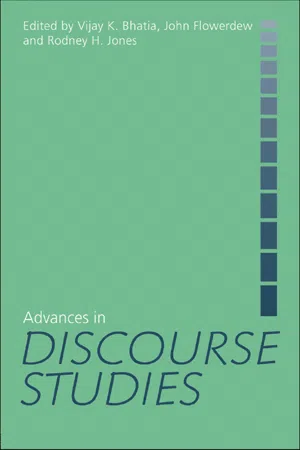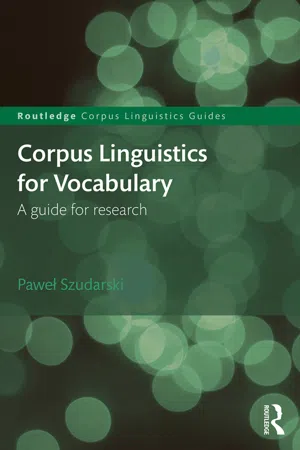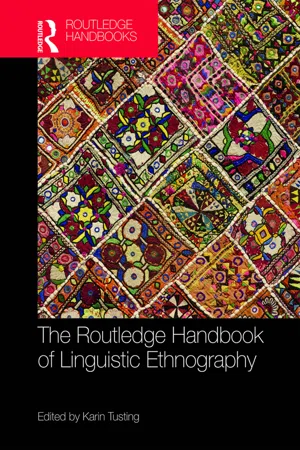Languages & Linguistics
Discourse Analysis
Discourse analysis is the study of language in use, focusing on how language is used to convey meaning in different social contexts. It examines the structure and patterns of communication, as well as the social and cultural factors that influence language use. Discourse analysis helps to uncover underlying meanings and power dynamics within language interactions.
Written by Perlego with AI-assistance
6 Key excerpts on "Discourse Analysis"
Learn about this page
Index pages curate the most relevant extracts from our library of academic textbooks. They’ve been created using an in-house natural language model (NLM), each adding context and meaning to key research topics.
- eBook - ePub
- Vijay Bhatia, John Flowerdew, Rodney H. Jones(Authors)
- 2008(Publication Date)
- Routledge(Publisher)
1 Approaches to discourse analysisVijay K. Bhatia, John Flowerdew and Rodney H. JonesIn recent decades the social sciences have undergone a ‘discursive turn’ and become increasingly interested in the part played by language in the creation of the reality that surrounds us. This interest has been accompanied by the development of new theories and methods for the study of language use and its role in human society. Discourse Analysis, though often seen as located within the discipline of linguistics, is in fact an interdisciplinary field of inquiry. With a history of less than 50 years it has acquired the status, stability, significance and integrity of a well-established discipline, extending the conventional boundaries of linguistics. Dating back to the 1960s, it has been defined as the analysis of linguistic behaviour, written and spoken, beyond the limits of individual sentences, focusing primarily on the meaning constructed and interpreted as language is used in particular social contexts.This definition really contains two main ingredients: the idea that language can be analysed not just on the level of the phoneme/morpheme, the word, the clause or the sentence, but also on the level of the text, and the idea that language ought to be analysed not as an abstract set or rules, but as a tool for social action. Although early conceptualizations of Discourse Analysis were seen as an offshoot of linguistic analysis, focusing more on the ‘language as text’ side of the equation and drawing on the work of early text analysts like Propp (1958) and Jakobson (1937), in its present form it has moved to more of a focus on ‘language in use’, drawing on insights from sociology, psychology, semiotics, communication studies, rhetoric, as well as disciplines such as business and marketing, accountancy, organizational studies, law and information technology, to name only a few. In this regard, it has evolved as a fruitful way of understanding the use of language in a variety of institutional, academic, workplace and professional settings. - eBook - ePub
Corpus Linguistics for Vocabulary
A Guide for Research
- Paweł Szudarski(Author)
- 2017(Publication Date)
- Routledge(Publisher)
p.160 Chapter 9 Discourse, pragmatics and vocabulary 9.1 What is discourse and Discourse Analysis?Discourse is a notoriously difficult term to define but in general “it refers to units of language above the level of the sentence” (McEnery and Hardie 2012: 132). In a detailed definition, Thornbury (2010) enumerates three main senses of the term: discourse as connected text, discourse as language in use and discourse as social practices. Similarly, Gee (1999) distinguishes between discourse (with a little d) and Discourse (with a capital D). While the former is concerned with language in use in specific contexts, the latter involves not only linguistic practices but also systems of knowledge, beliefs and other elements of social life. This distinction is also reflected in Groom, Charles and John’s (2015) discussion of discourse-oriented approaches. The authors posit that there are two basic types of Discourse Analysis: the first one concentrates on the structure of different kinds of interactions and the other is the study of conventionalized meanings, values and ideologies held by specific social groups.What transpires from the above definitions is that Discourse Analysis is an umbrella term and it encompasses a set of mainly qualitative methods and practices aimed at exploring specific examples of language in use and studying how meaning emerges in the process of interaction (Biber, Connor and Upton 2007). Corpus linguistics, in turn, tends to be perceived as a quantitative methodology, which relies on frequency data and statistical procedures and seeks to reveal typical patterns of natural language use. It becomes evident then that there are inherent differences between these two approaches to the study of language. Nevertheless, both Discourse Analysis and corpus linguistics are interested in naturally occurring linguistic data (Flowerdew 2012) and consequently they can be usefully integrated and complement each as is manifested by findings from corpus-assisted discourse studies (e.g. Partington 2004; Partington, Duguid and Taylor 2013). Operating on this premise, in the following sections you will learn how research at the interface of Discourse Analysis and corpus linguistics can provide new insights into vocabulary as a key element of authentic discourse. - eBook - ePub
- Karin Tusting, Karin Tusting(Authors)
- 2019(Publication Date)
- Routledge(Publisher)
While one can historically detect a gradual progression from an early, more narrow linguistic interest in the formal and functional mapping of various aspects of the situated utterance to a later, more process-oriented research perspective which lends priority to social questions such as the connections between language and identity, it is probably more accurate to state that Discourse Analysis has crystallised within language studies in two directions. One can note, on the one hand, a continuation of more linguistic uses of the term, in which discourse is viewed as the layer of meaning which is tied more directly to situations of language use. The focus here is often on large collections of verbal material of a particular situation or activity type and the use of quantitative methods and techniques of corpus linguistics (Biber et al., 2007). Specific discourse-related themes are selected for closer attention (e.g. Warren, 2006 on aspects of naturalness in informal conversational language use). On the other hand, recent decades have witnessed the formulation of a broad project of discourse studies which more holistically views language use, often in combination with other forms of semiotic behaviour, from the angle of ‘social practice’. Much discourse research thus simultaneously attends to aspects of text and talk, processes of interpretation and cognition, and social-actional dimensions of communicative behaviour as well as its functioning at the level of ideological reproduction and socio-cultural transformation.Especially in the latter tradition, Discourse Analysis has often (if not mostly) stood in an applied relationship to the social world, with discourse research oriented to the identification of recommendations for practice (here echoing Brumfit’s definition of applied linguistics as engaged with real-world problems and issues in which language plays a central role (Brumfit, 2001)). A quite arbitrary list which attempts an impression of the range of possible themes could include: contextual complexity in the processing of cartoons by patients with unilateral lesions (Dagge & Hartje, 1985), the effects of story sequencing on affective reactions to news broadcasts (Mundorf & Zillman, 1991), self-commodification in dating advertisements (Coupland, 2006), pedagogical focus in foreign language classrooms and the use of repair strategies (Kasper, 1986), media coverage of the genetically modified food debate (Cook et al., 2006), the communication of rights in contexts of police arrests and detention (Rock, 2007), and so on and so forth. Themes under the heading of registering discourse change in response to shifts in socio-cultural values are also many and varied. One such theme has been the interest in ‘technologies of discourse’ (Fairclough, 1992; Cameron, 2000). - eBook - ePub
Analyzing Text and Discourse
Eight Approaches for the Social Sciences
- Kristina Boréus, Göran Bergström(Authors)
- 2017(Publication Date)
- SAGE Publications Ltd(Publisher)
Thus, according to the distinction between broad and narrow discourse definitions, the narrowest way of conceptualizing discourse is when the term refers to chunks of text without context, while the second broadest definition refers to linguistic practices, related to other kinds of social practice. The broadest definition includes linguistic as well as other kinds of social practice (see the example of university teaching as a discourse in Section 1.1).There is also another kind of distinction between different uses of the term discourse in the literature. Sometimes ‘discourse’ refers to a particular perspective – an ideological view or a particular way of understanding – on a phenomenon. In accordance with this definition, what is expressed about a phenomenon at a particular time, in an institution, might be the expression of more than one, perhaps contradictory, discourses. But sometimes ‘discourse’ refers to the patterns for how a certain phenomenon tends to be talked and written about at a particular time in a particular context or institution. According to this latter kind of definition, a particular discourse might harbour internal contradictions and tensions.8.1.2 Discourse Analysis as philosophy and social theory
Discourse Analysis offers an opportunity for a broader form of textual analysis that is based on a number of theoretical points of departure, which we present in this section. Under the subheading ‘Critical reflections’ we return to these theoretical preconditions.First, Discourse Analysis embraces a view of language and language use which suggests that language is not conceived as a neutral instrument for communication. The view that language represents a given reality is rejected. Instead, the formative and constitutive side of language is emphasized: language always involves a perspective on the world. This does not mean that Discourse Analysis denies the existence of non-linguistic spheres: i.e. a “reality out there”. Laclau and Mouffe (1990: 100–3) exemplify this with the example of a stone. That every object is viewed as discursively determined need not entail the view that the stone only exists when defined by a “system of socially constructed rules”, it only means that the stone may assume different significations. For a stone-age warrior it might be a potential tool, for a settler it might be part of the foundation of a future dwelling and for some students it might be an archaeological discovery. Viewing language as constitutive entails that different interpretations of the stone create the basis for our knowledge, and the issue of power involves having certain knowledge accepted as the correct knowledge. Social life is not fixed, and the context for people’s lives is continuously in the process of being constituted. - eBook - ePub
- James Simpson, James Simpson(Authors)
- 2011(Publication Date)
- Routledge(Publisher)
Critical Discourse Analysis, the investigation of how ‘language use may be affirming and indeed reproducing the perspectives, values and ways of talking of the powerful, which may not be in the interests of the less powerful’.Language development as it relates to individual neurological and psychological processes, and to the broader social context, is the focus of the following three chapters. Elisabeth Ahlsén notes that Neurolinguistics, the study of language and the brain, is a truly interdisciplinary pursuit, involving neuroscience, psychology, linguistics, speech pathology and biology. Its relevance to therapy in particular makes it an applied linguistic concern. In his chapter Psy-cholinguistics, John Field explores some familiar territory for applied linguistics, as he examines the cognitive processes at play in language use and acquisition. Sociocultural and Cultural-Historical Theories of Language Development, explain Steven Thorne and Thomas Tasker, view mental development as fundamentally constructed through ‘engagement with cultural practices, artifacts, and milieus’. This understanding of language development stresses the relationship between an individual's development and ‘the social and material conditions of everyday life, including those comprising formal instructional settings’.Sociolinguistics – the topic of the chapter by Carmen Llamas – is itself a broad field of language study, and concerns language in social contexts, language change and variation, and the signalling and interpretation of meaning in interaction, all matters of central relevance and connection to applied linguistics. Janet Maybin and Karin Tusting write on Linguistic Ethnography, a fast-growing area which combines ethnography with linguistics and other strategies to investigate social processes. Perhaps because of its emic perspective and sensitivity to contextual features, linguistic ethnography is emerging as a key paradigm for investigating language in use in the world today. Doris Warriner adopts an approach to Literacy which also regards language and literacy practices as contextually situated. Such practices – as she says – can be seen not as problems but as resources ‘which might be differentially valued and supported depending on situation, place, audience, and goals’. Finally, in this section Stylistics - eBook - ePub
Poststructuralist Discourse Analysis
Subjectivity in Enunciative Pragmatics
- J. Angermuller(Author)
- 2014(Publication Date)
- Palgrave Macmillan(Publisher)
Before the symbolic material can be analyzed, we need to formally identify the sentences of the corpus. In a second step, these sentences can be analyzed as specifically produced utterances of a discourse. Only now does one begin to deal with the discursive processes triggered by these utterances, which make certain specific contexts of enunciation deictically visible, allow different sources of discourse to have a voice, and may presuppose and preconstruct certain stocks of knowledge. In a third step, one has to enquire how the interpretive processes triggered by utterances configure the social relations between the individuals entering into the discourse. In following this methodological procedure, we will account both for the (linguistic) world of symbolic forms as well as the (social) world of the individuals, producers and groups. If the abstract signs, the grammatical sentences, the repeatable texts are, as it were, located ‘beneath’ the discursive, then the non-repeatable contexts, the interactive situations and the social relations between the individuals are located ‘above.’ The question of Discourse Analysis is: how are texts and contexts linked through the enunciation?In order to enquire into how texts instruct readers about the contexts in which they are uttered, the analyses will treat in turn three problem areas:- The problem of indexicality or discursive deixis: how do utterances point to their contexts in the enunciation? What is marked as a relevant context?
- The problem of polyphony and dialogism: how do utterances orchestrate their voices and speakers? Who is responsible for what is said? Who’s speaking?
- The problem of the preconstruct: what are the traces left by what was said before and elsewhere? What are the signals for self-evident knowledge?
This analytical procedure directs its focus on the heterogeneity of a complex, convoluted and knotted discursive object. Instead of an ideal immaculateness which draws its meaning from itself, the following discourse analyses examine texts which are connected with an amalgam of the most different (cognitive, situative, institutional…) contexts. Instead of a transparent medium through which a timeless truth shimmers, they deal with texts which do not easily impart the illusion of lived meaning even among readers with a great discursive competence, who have differentiated knowledge of the contexts of production and approach reading with great patience. We therefore must not understand the discourse as a closed totality in which all elements mutually define one another. Rather, if we want to account for how these utterances are uttered in specific contexts, we should reflect the blanks and gaps, what is not said and what cannot be ultimately decided. Instead of retrieving a core of meanings, we will ask how utterances can be cited, made use of and reinscribed into different contexts. Instead of a lonely monologue, the analyses will register a chorus of voices which are entangled and superimposed upon each other, which are brusquely rejected or respectfully accepted, which face each other in antagonistic opposition or in harmonious accord. If the reader wants to know how the other individuals—those who have written the text and those who will read them—set themselves apart from each other, refer to each other and position themselves in the intellectual field, the reader must somehow orient her- or himself in this maze of allusions, in these murmuring voices, in this parcours strewn with pitfalls. How much easier it would be if the actors could just assume social positions directly, without the detour through symbolic forms. The problem is, they just can’t.





